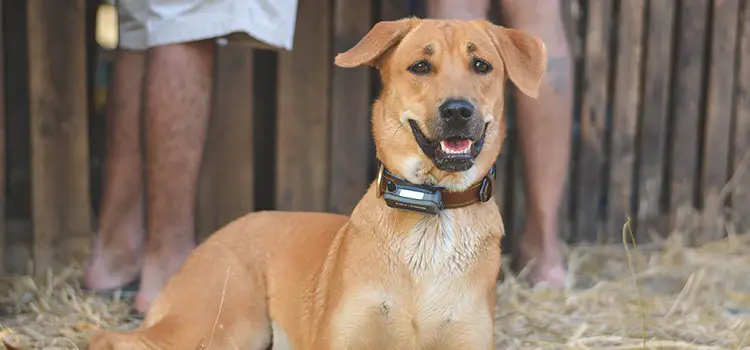Choosing the right collar for your furry friend can be like choosing a shirt for yourself to wear on a given day. There are numerous styles, colors, and purposes for each shirt you may own and likely the same could be said for the potential collar you buy for your pet.
Since your Labrador will not be changing his collar daily, it is important to choose the right training collar for your dog. In many areas, collars and leashes are required by law, while some areas require identification tags on your pet as well.
A Standard Collar’s Objective, Style, and Fit
While fashion can be included in your decision for the perfect collar, it is important to remember that a collar’s primary objective is safety and control. From training your pet to enjoy the outdoors on a walk, it is imperative that the collar is able to keep your pet safe and under control. This can be more of a task for any large dog breed included the Labrador due to their size and strength. This is also a great way to be reunited with your furry friend if they were to get lost, as there are identification tags on the collar.
Collars can be chosen in many styles ranging from thin, decorative, and colorful straps to complete full-body harnesses for better control of that strong animal on the far end of the leash. The answer to which collar is best for any given animal is not easily definable as any two animals, even of the same species and breed, may act completely different and require different features to best meet the needs.
The key to a proper fit remains the same for all dog breeds. Experts describe the correct collar fit as being snug enough to fit two fingers in between the neck of the dog and the collar. Any smaller of a collar may restrict the animal and make it uncomfortable; any larger of a collar would potentially allow the companion to slip the collar off, yielding it useless.
The Collar and the Harness
Harnesses are very common among large dog breed owners such as the Labrador as they help distribute the force across the chest and shoulders of the animal rather than just the neck. This is great for training if the animal continually attempts to run away from the trainer, then it can help prevent injuries to the neck and the trachea of the pet.
It also helps when the dog grows larger and provides more control. As your Labrador becomes trained to walk on a collar and leash, it may become a less strenuous activity. With proper training, walking with a leash and collar may no longer feel like a game of tug-of-war with your friend, which can provide the opportunity to use a neck collar instead of a full harness.
Unlike the harness, a neck collar serves the same importance and same functions but is much more the standard issue for any puppy or dog. The standard neck collar can vary in thickness and width and will need to be measured and purchased specifically for your Labrador.
These neck collars can be adjusted in size but over the lifespan of your companion will need to be changed as the dog grows from a young puppy to a mature adult Labrador.
Over the course of its lifespan, the average Labrador grows over 60 lbs. and respectively, the neck size will grow with the dog, meaning that you may need to purchase quite a few different collars over the course of the dog’s life.
Training Collars and Slip Collars – Materials & Clasps
Training collars and slip collars are both types of collars that are not made for general use to simply wear around the house. These collars are designed to aid in the training of your pet and or specifically for talking walks with your pet. Many of the collars that fit into the range are made from either nylon or metal depending upon the design.
Slip collars work so that if the pet attempts to get “out of range” or further than they should then the collar would tighten around the neck to teach the pet not to go that far away again. Some training collars even include spikes or prongs to aid in training the most stubborn of pets however they are frowned upon by many.
Also included in this category would be bark training collars and electronic fence collars. Both of these types of collars feature electronic devices to train the dog to act accordingly; for bark collars that are to receive a small shock if barking and for electronic fences typically to receive a small shock if the pet leaves the specified area.
As difficult as choosing the type of collar you want next, you will need to choose the materials. The most common materials used for collars are cotton, leather, and neoprene, although there are more choices available. Some collars are made from multiple materials such as leather and neoprene.
The difference in materials can be both aesthetic and functional at the same time, depending upon the lifestyle of you and your pet. Leather is a great material and a good quality of leather can last for years if properly maintained.
The same can be said for both cotton and neoprene collars which have the added luxury of colors and designs that you would not typically see on a leather collar.
The clasp of the collar is another factor to consider when making your purchase. Typically leather collars function like that of a person’s belt with eyelets and a buckle. As the dog grows older, it may be as simple as moving the buckle to the next eyelet to allow for growth.
Once the dog has grown to a size where there are no more eyelets, then it is time to purchase a larger collar. Many neoprenes and softer material collars may include plastic quick-release buckles. These collars typically adjust in size by cinching the material through the buckles.
As the dog grows larger, you can easily adjust the collar by un-cinching the material. Once the collar has been stretched to its maximum width, it will require replacement if the pet continues to grow.
Remember to Inspect the Collar
One important key to remember is to regularly inspect the collar that you decide to use for your pet. If the material shows signs of wear and age, it should be replaced immediately. We are relying on these collars to protect our companions from both danger and loss, and if the collar fails, then it defeats its purpose. If your collar is carrying an identification tag, it is also important to keep the information on the tags up to date, or they become useless as well.
So, Which Training Collar is best for My Lab?
While we have covered the many types, styles, and objectives, you may still be wondering about the best training collar for your dog.
Training collars can be as advanced as sending a shock, vibration, or tone to let the dog know the instructed command was not correct. Other training collars may be intended for leash training to prevent the dog from pulling or lunging during walks.
Whether you are training to execute commands or you are training to teach proper leash practices, you will need the appropriate collar for successful collar training.
Rechargeable Dog Collar w/ Three Training Modes
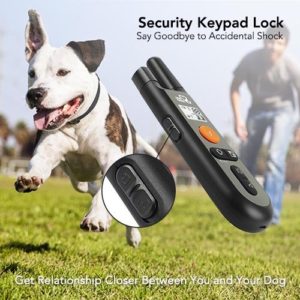
Safely training your dog to respond through a collar is a top priority, and this electronic rechargeable dog collar by DOG CARE will do just that!
This safe training collar includes three training modes: beep, vibration, and shock. This collar reaches a total of 330 yards with extensive battery life. Accommodating dog sizes from 15 to 100 pounds, this collar is perfect for Labradors, as well as any other dog you may have in your home.
You can easily train your dog to follow commands through the use of this safe, effective, and affordable training collar.
StarMark Training Collar
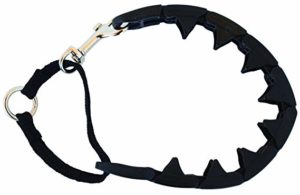
If you are looking for a basic, affordable collar to connect to your leash, this training collar by StarMark is perfect for training your Lab to respond to basic leash commands.
As Labradors are large, strong dogs, they can easily pull you while being walked on a leash. This training collar prevents pulling and lunging behavior. This collar is also adjustable to fit your Lab’s exact neck size.
Using this training collar during leash training will help your Lab learn basic leash skills, as well as refrain from pulling and lunging during walks.
Hot Spot Pets Wireless Rechargeable Dog Training Collar
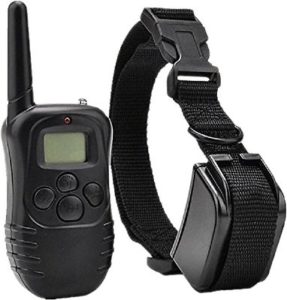
One of the most affordable and effective dogs training collars is the Hot Spot Pets dog training collar. This training collar has all the features you need to train your Lab at an affordable price!
This collar offers 100 levels of vibration or shock to safely and effectively train your Lab. The battery life lasts several days and requires to be charged a total of 3 – 4 hours between uses.
For best results, training sessions should be between 15 – 45 minutes, with limited vibration or shock training required in order to keep the training session positive.
SportDOG GPS Tracking & Training Collar
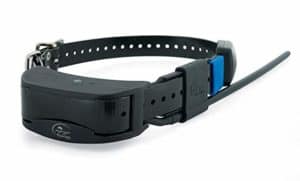
In today’s technology, one of the most useful innovations is GPS tracking, and there is no better way to know exactly where your dog is than by using GPS!
The SportDOG GPS tracking and training collar offers 99 levels of training shock with additional vibrations and tones. This collar is especially ideal for Labradors that spend time outdoors learning to retrieve waterfowl or other hunted game.
While this tracking and training collar is expensive, there is no price on the peace of mind you will have knowing the exact location of your Labrador!
Conclusion
As a responsible dog owner, you will need to decorate your Labrador with appropriate identification. The standard dog collar is ideal for your Lab to being identified if he wanders from home. Additionally, a standard collar can show off your Lab’s personality through color, pattern, or design.
Taking collars a step further than being a decorative way to adorn your dog with identification, collars are also an effective way to practice appropriate training. Whether you are practicing leash training or command training, a training collar for your Lab can assist in fulfilling a successful training session.
Electric training collars are a useful way to incorporate an additional training approach with a typical approach. Electric training collars are intended for limited use during the day, usually between 15 – 45 minutes in a training session.
As positive reinforcement while training your Lab is essential for best results, limiting the amount of collar training on your Lab will help your Lab want to continue to learn.
Reminders
Be patient and positive with your Lab through all means of training. While your Lab is a highly intelligent dog, he has to learn the commands being instructed. Do not become frustrated if your Lab does not execute the command on the first try, and do not punish your Lab for failing to execute a command.
Your Labrador can sense your demeanor. If you are frustrated, your Lab can become frustrated. A frustrated owner with a frustrated Lab is a recipe for a disastrous training session.
Enjoy the moment with your Lab throughout the good and bad. Keep in mind that not every training session will be a success. Do not expect your Lab to learn every command on the first attempt. Having realistic expectations and a positive training session will keep you and your Lab happy and encouraged.
The last key to positive reinforcement through training is to reward your Lab with plenty of petting, treats, and praise. Your Lab is a loyal companion that will put your happiness first. Knowing that you are happy will keep your Lab on his best behavior all throughout the training sessions.
